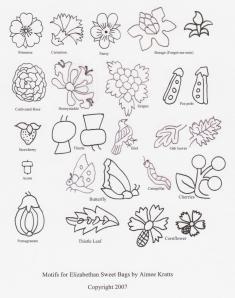Materials
Materials for sweet bags and pin cushions vary in the extant examples. The bodies of the bags were usually made from linen canvas, but leather and velvet were also used. One sweet bag (V&A T.10-1922) was even embroidered on paper. Embroidery threads include colored silk, gold thread and silver thread. Embellishments include spangles (sequins), glass beads, seed pearls and silk ribbons.
Stitch Techniques
To paraphrase a V&A description of item number T.247-1960, the embroiderer “used a linen canvas ground with an open weave so that stitches of silk or metal thread could be worked over each intersection of warp and weft in a regular manner. A variety of stitches such as tent, cross, plait and Gobelin stitch.” Other stitches used on sweet bags include chain stitch, double chain stitch, plaited braid stitch, and knots.
Motifs
Patterns were taken from botanical books or pattern books such as The Needle’s Excelency published by James Boler in 1631. The flower, bird, and insect motifs used most frequently in the extant sweetbags that I have reviewed are (in order of frequency):
primrose (wild rose)
carnation
pansy
borage (forget-me-nots)
cultivated rose
honeysuckle
grapes
peapods
strawberry
thistles
birds
oak leaves/acorns
caterpillars
butterfly
daffodil
cherries
stag
cornflower
pomegranate
bunny
Elizabethans knew about two types of roses: wild and cultivated. Wild roses have five petals. Cultivated roses have many more petals.


